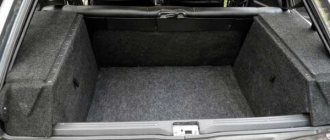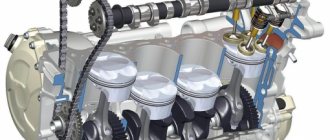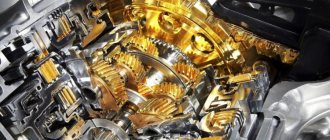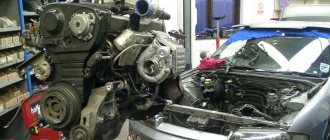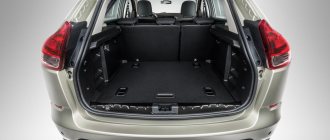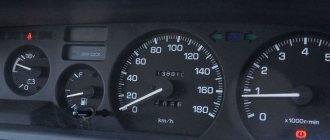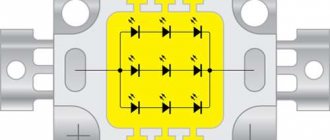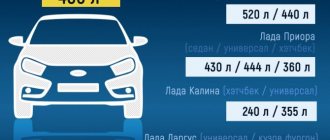Car engine size is the sum of the working volumes of its cylinders. The units of measurement are both cubic centimeters (cm3) and liters (l.) (1 liter is equal to 1000 cubic centimeters):
1l=1000cm³
When the value must be indicated in liters, when converting units of measurement, rounding is done to a whole number after the decimal point, for example, if the value is 1598 cubic centimeters, the liters will be 1.6 liters, and, for example, the volume of 2429 cubic centimeters will be 2. 4 liters.
The vehicle's power, fuel consumption and other operating parameters directly depend on the engine displacement.
There are several ways to find out engine size:
- This characteristic is indicated in technical passport vehicle. There are “craftsmen” who like to advise unscrewing all the spark plugs and pouring water into the cylinders “to capacity”. The volume of water placed in them, according to them, should be the same as that of the engine. This method should not be used, as it is just an old joke.
Click on photo to enlarge - If you buy a used car, the numbers indicated in its registration certificate may not be entirely correct. It is possible that the car was involved in an accident or perhaps some work was carried out on it that affected the engine's performance. What if it was actually assembled from several cars? The actual volume, in these cases, can be found out by looking at the numbers on the cylinder block. This is the value of the working volume. They are indicated at the back with large symbols (you can see them from the pit).
- And of course, according to the VIN code.
How to find out engine size by VIN code? Decoding the VIN code
You can also find out the engine size by the VIN code. You can see it at the bottom of the driver's door arch, naturally, after opening it first. It is also indicated under the rear seat, under the windshield and in the upper left part of the instrument panel (in this case, the code must be looked at from outside the car).
The last method listed is the most reliable. Since the VIN code is indicated on all cars that were produced starting from about 1980. It consists of seventeen characters, among which the Latin letters I, O and Q are not used due to their similarity with the numbers 1 and 0.
- The first three characters indicate the car manufacturer's index. (The first is the geographic area code, the second is the country code in that geographic area, and the third is the manufacturer's symbol).
- The fourth to eighth digits inform about the main technical parameters of the car: model, engine type and size, body type, and so on.
- The ninth character is the check digit. It is needed so that the authenticity of the VIN code can be determined. With its help, you can find out whether the car is listed as stolen.
- The twelfth to seventeenth characters are the car body number.
Engine Model Number
You can also obtain information about the engine model by the number, which is indicated directly on the unit - under the hood, closer to the windshield. Only older American-made models do not have it there, but even on modern cars it is not always easy to find and read it - dust, dirt, soot and corrosion take their toll.
The engine number is 14 characters:
- The first 5 characters are descriptive information about the base model, modifications of a particular car and climate class.
- 6th symbol – Latin letter A (diaphragm clutch) or P (recirculation valve).
- The last 8 characters are index information (month and year of manufacture, individual serial number).
To determine the engine model, the first three digits of its number, which characterize the indices of the base model and configuration, are of informational value.
By the engine number you can determine its model. But only if you navigate the information and know how to then use it. If the features of car markings are unclear to you, a more suitable way to get the information you are looking for would be an online search specifically by VIN code.
Calculator for calculating the cylinder displacement of a car engine
The formula for calculating a cylinder has been known since school curriculum - the volume is equal to the product of the area of the base and the height. And in order to calculate the engine volume of a car or motorcycle, you also need to use these multipliers. The working volume of any engine cylinder is calculated as follows:
How to find out engine size
Note that the full volume and the working volume are different, since the piston has bulges and recesses for the valves and also includes the volume of the combustion chamber. Therefore, you should not confuse these two concepts. And to calculate the real (total) volume of the cylinder, you need to sum up the volume of the chamber and the working volume.
Thus, if, for example, you find that the volume is 1598 cm³, then in liters it will be designated as 1.6 liters, and if the number is 2429 cm³, then 2.4 liters.
Why do you need to check engine size?
What is engine displacement and how to calculate it
The very first assembly of an internal combustion engine (ICE) dates back to 1885 and was carried out by German engineer Karl Benz. Since then, engineers have been constantly trying to improve the dynamics of engines. And the expression “engine displacement” is always heard, but not everyone knows what engine displacement is in reality and what parameters it consists of. In many countries, car taxation is determined by the displacement of their engines. For example, in Japan, owners of Kei Cars, which belong to the class of small cars and have an engine capacity of 0.66 cm cubic, do not pay road tax. In some countries around the world, tax legislation is structured so that the larger the engine displacement, the higher the road tax. As for Russia, here the amount of road tax is determined by the number of horsepower, although these two parameters are completely interrelated. From all of the above, we can conclude that engine size is an indicator of the car’s power, as well as the solvency of its owner.
This technology is already used on some new American-made SUVs, thanks to which it is possible to save about 20% of the fuel mixture. Currently, in the experimental stage, special engines with mechanical changes in the piston stroke are used. But internal combustion engines with variable displacement have already been used for some time as laboratory equipment, for example, when determining the octane number of gasoline using the “engine method”.
Engine displacement characteristics
The working volume of all types of engines is usually measured in cubic centimeters, or liters. It is according to these parameters that machines can be divided into the following categories:
- minicars (no more than 1.1 liters);
- small cars (from 1.2 to 1.7 liters);
- medium volume (from 1.8 to 3.5 liters);
- large-capacity (from 3.6 or more liters).
But along with fuel consumption, the power of the car also increases, because more fuel will produce a greater amount of released energy.
The disadvantages of large-capacity cars, in addition to fuel consumption, include their higher cost. So, it is logical to assume that much more materials will be required for its manufacture, and the requirements for the quality of manufactured parts will, accordingly, be much higher.
How to calculate engine size
- For example, if a car has an inline four-cylinder engine, and the volume of each individual cylinder is 499 cubic centimeters, we should multiply this number by four.
- As a result, we will get a value that determines the displacement, in our case it is 1996, then we round it to the nearest whole value. In our case it is 2000, then we divide this value by 1000, and this means that this engine will have a volume of two liters.
The principle of operation of the internal combustion engine
Operating principle of an internal combustion engine:
- The combustion chamber of the power unit is filled with a fuel mixture (gasoline with air). The chamber is designed so that it has a movable element (piston).
- Then, using a special device called a “spark plug,” the fuel mixture ignites.
- The energy released as a result of the “explosion” pushes the piston down, which in turn transmits the movement to the crankshaft, which, through various gearboxes, begins to spin the wheels.
How to increase engine size
As a result, how can you increase engine power yourself? Typically, there are several ways to solve this problem. It all depends on how much you want to increase the power output of the engine and of course on the size of your wallet:
The simplest and cheapest option is simply boring the cylinder block to increase the combustion chamber. In this case, your costs will only be associated with the purchase of new pistons of larger diameter. A more expensive option is to replace the “original” crankshaft with a shaft with a larger crank radius. Well, since the diameter of the connecting rods will increase, you will have to change the entire piston group. After this procedure, the stroke of the pistons will increase, and, accordingly, the displacement of the power unit will become larger.
What method to use to increase the power of a car is a personal matter for everyone. But it is worth remembering that boosting the engine at home is simply unrealistic. This requires special equipment, and most importantly, highly qualified specialists. So, if you still decide to take such a step, you have a direct route to a tuning agency.
The principle of operation of the internal combustion engine
Operating principle of an internal combustion engine:
- The combustion chamber of the power unit is filled with a fuel mixture (gasoline with air). The chamber is designed so that it has a movable element (piston).
- Then, using a special device called a “spark plug,” the fuel mixture ignites.
- The energy released as a result of the “explosion” pushes the piston down, which in turn transmits the movement to the crankshaft, which, through various gearboxes, begins to spin the wheels.
This is the simplest description of the operation of the engine; in fact, there are a huge number of nuances, but it also allows us to answer the question of how to find out the volume of a gasoline engine.
Now it is clear that the volume of any engine is the total value of all combustion chambers of the engine. What does this indicator affect? First of all, on the power of the car. Although modern cars are increasingly using turbocharging, which allows inventors to increase power while leaving the volume of the combustion chamber unchanged.
How to find out the engine size of a car
Types of engines
Diesels are more reliable due to the fact that they operate without electronic devices, and even in the event of a breakdown, repairing such engines will cost much less than gasoline ones.
Powertrain differences
A powerful car will serve you for a long time, and if used correctly, it will also be a reliable assistant, because the engine does not suffer from overload and can be fully operated with the air conditioning and other electronic systems turned on.
- Engines with a volume of 0.8 to 1 liter. They are mainly installed on vehicles for transporting goods due to their low power. They consume about 5 liters per 100 kilometers.
- Units with a volume of 1.2 to 1.8 liters are quite suitable for everyday driving; they have low fuel consumption, around 5–10 liters per 100 kilometers.
- The golden mean is 1.8–2.5 liters. Low tax, reasonable consumption and confident acceleration - both in the city and on the highway.
- Engines with a volume above 3–4.5 liters are installed on expensive foreign cars.
- Cars with 5-liter units belong to luxury categories and are subject to increased taxes.
Determining engine size
Now let’s talk about how to find out the displacement of a car unit. There are several ways. You can look at the volume in the car’s technical passport, but this method is not entirely suitable when buying a used car. Perhaps the engine configuration was changed or modernized. The actual value can only be found on the cylinder block.
You can also determine the engine displacement by the VIN code. You should look for it under the rear seat, under the windshield, or at the bottom of the driver's door arch. This code consists of seventeen characters.
Types of engines
How to decide on a motor unit? Let's first understand its classification. So, the heart of a car is divided into several types: internal combustion engines and electric motors. However, due to the problem of charging electric cars, the most popular are cars with internal combustion engines. They are divided into gasoline and diesel. Their difference is that engines running on gasoline require an electric spark, which is important for igniting the fuel. The fuel mixture in diesel units can ignite on its own. Each type of engine has its own advantages and disadvantages.
Cars with a diesel engine have more torque, they are more economical, by about 20 percent, and accordingly, such cars have a longer range. Diesels are more reliable due to the fact that they operate without electronic devices, and even in the event of a breakdown, repairing such engines will cost much less than gasoline ones. As for the disadvantages of engines running on diesel fuel, first of all, this is their weight, which negatively affects the maneuverability of the car; in winter the car will have to warm up for a long time.
In vehicles with a gasoline engine, which is jokingly called a “lighter,” the maximum power is slightly higher than diesel engines and, accordingly, the maximum speed is also higher. But they have a smaller appetite and are less reliable. There are cars with an electric unit. However, they are much more expensive than usual and the problem of charging the engine is still relevant, not to mention the maintenance of such vehicles.
Calculating engine cylinder volume: tips, explanations, formulas
Calculation of cylinder volume
The concept of cylinder displacement
Detonation can be identified by a sharp knocking sound, a decrease in engine power and thick black smoke from the exhaust pipe. Automotive designers are constantly looking for ways to eliminate fuel detonation when increasing the compression ratio. The compression level determines the need to use a specific type of fuel.
Variable displacement
Online calculator
The volume of a cylinder can be calculated using:
- base radius and height, with the height equal to the piston stroke;
- base area and height.
But there are also more complex calculators with an expanded range of functions. They allow you to calculate not only engine volume, but also the compression ratio. For calculations, the values of the following parameters are required:
- connecting rod length;
- piston stroke;
- piston under-return;
- cylinder diameter;
- piston chamber volume;
- thickness and diameter of the gasket;
- chamber volume in the cylinder head;
- number of cylinders.
Before calculating the volume of a cylinder or the entire engine, or calculating the compression level, you should clarify and record all of the above parameters. Beginners may have difficulty with this, so they will have to be persistent.
Cylinder volume: what formula to use
To solve this problem, a convenient tool can be useful - an online calculator. If you are interested in the question of how to find out the working volume of a cylinder in your own passenger car , you will need some of its characteristics, namely height and radius divided by diameter.
You can independently calculate the volume of a cylinder using the formula:
V=πr2h
- The symbol V denotes volume,
- R - radius,
- h - height,
- π is the number Pi.
If the diameter is known, then the formula will help calculate the volume of the cylinder:
V=(πD2/4)h
Instead of the radius, the diameter value is indicated. Having the necessary characteristics, computing operations will not seem like a complicated process.
Car engine power calculator
Pit calculation calculator, cost of excavation work, calculation of pit volume of different shapes
Tire load index calculator
Injector performance calculator
Calculator for empirical calculation of oil change intervals based on actual fuel consumption
Engine size - how it works and what it is and what it affects
The engine is the heart of the car, so when choosing a car, buyers often pay attention to one important factor - its volume. However, few people have any idea what engine displacement is and what it affects.
Let's start with a definition - the engine displacement is the sum of all the volumes of the car's cylinders, where the piston volume is the product of the piston area and its stroke, and the piston stroke is the distance from top dead center to bottom dead center. In simple terms, cylinder volume is the volume of the combustion chamber, where ignition and combustion of fuel occurs. Engine volume is calculated in cubic centimeters or liters. One liter is 1000 cubic centimeters. Depending on the volume, cars are divided into mini-displacement - up to 1.1 liters, small-displacement - 1.2-1.7 liters, medium-displacement - 1.8-3.5 liters and large-displacement - over 3.5 liters. This division is mainly used for cars with gasoline engines.
How does a car engine work?
On the reverse side, the piston is attached to the crankshaft, through which the pushing force is transmitted to the wheel axle, which sets the car in motion. The more fuel is burned, the stronger the shock will be.
Accordingly, a large combustion chamber will provide more engine power than a small one. This is, of course, a very simplified explanation; in practice, power is influenced by many factors.
What is engine displacement?
How cars are divided into classes based on engine size
The installation of a particular motor on a specific model directly depends on what characteristics the car should demonstrate (acceleration dynamics, torque, maximum speed, etc.).
Much higher costs are required compared to the manufacture of a three-cylinder engine with a volume of 0.8 liters.
What does engine size affect?
- Firstly, gasoline consumption. The larger the cylinder volume, the more fuel is needed to ignite it with maximum efficiency, and accordingly, consumption increases. However, this minus turns into an equally tangible plus. The larger the engine displacement, the greater the engine power, since more gasoline releases more energy.
- Secondly, as already noted, the larger the volume, the greater the power, that is, a car with a larger engine will accelerate faster, be able to carry heavier loads and more passengers
Their consumption in city traffic will be minimal compared to other cars, but, in turn, such cars are not suitable for long journeys, since at speeds over 100 km/h they clearly do not have enough power.
Increase in engine displacement
For this reason, during deep tuning of a car engine, it is better to immediately change the engine, that is, install another engine with an initially large displacement, which can then be additionally bored to the second or final repair size.
Classification of cars based on engine size
Since there is no vehicle that would meet the needs of all motorists, manufacturers create engines with different characteristics. Everyone, based on their preferences, selects a certain modification.
Based on engine displacement, all cars are divided into four classes:
- Minicars are cars with an engine whose volume does not exceed 1.1 liters. For example, such vehicles include CITROEN C1 and FIAT 500C.
- Subcompact cars are cars whose internal combustion engine capacity varies from 1.2 to 1.7 liters. Such machines are popular among those who value minimal consumption with average performance. Representatives of this class are DAIHATSU COPEN 2002-2012 and CITROEN BERLINGO VAN.
- Medium displacement - the power unit in such cars has a volume of 1.8 to 3.5 liters. This class includes models such as the BUICK REGAL TOURX and LAND ROVER RANGE ROVER EVOQUE.
- Large cars - in such cars the internal combustion engine volume will be more than 3.5 liters. Representatives of this class include: ASTON MARTIN VANQUISH VOLANTE 2013, CHEVROLET CAMARO 2022 and BENTLEY CONTINENTAL GT CONVERTABLE.
This classification applies to gasoline units. Often in the description of characteristics you can find slightly different markings:
- B - compact cars with a displacement of 1.0 - 1.6. Most often these are budget options, such as SKODA FABIA.
- C – this category includes models that combine an average price, good performance, practicality and a presentable appearance. The engines in them will be from 1.4 to 2.0 liters. A representative of this class is the SKODA OCTAVIA 4.
- D – most often these cars are used by business people and families. In cars, the engine will be 1.6-2.5 liters. The list of models in this class is no shorter than in the previous segment. One such car is the VOLKSWAGEN PASSAT.
- E – business class vehicles. The internal combustion engine in such models is most often 2.0 liters. and more. An example of such a car is the AUDI A6 2022.
In addition to displacement, this classification takes into account such parameters as the target segment (budget model, mid-price or premium), body dimensions, and comfort system equipment. Sometimes manufacturers equip middle and upper class cars with small engines, so it cannot be said that the presented markings have strict boundaries.
When a car model is between segments (for example, according to technical characteristics it is class C, and comfort systems allow the car to be classified as class E), “+” is added to the letter.
In addition to the mentioned classification, there are other markings:
- J – SUVs and crossovers;
- M – minivans and minibuses;
- S – sports car models.
The engines of such cars can have different volumes.
What makes up the useful displacement of an engine?
The engine, or rather its block, consists of several cylinders. Most often there are four of them, less often - six or eight, and in large SUVs and premium cars there can be ten or twelve. Sometimes there are engines with three or five cylinders.
The sum of the volumes of these cylinders is the working volume of the engine. In turn, the volume of each cylinder (more precisely, the volume of the combustion chamber of the cylinder) is the volume of space between the extreme positions of the piston (bottom and top dead centers). The location of the cylinders does not matter.
The volume of a cylinder is very rarely a multiple of an integer, usually it is 0.398 l, or 0.579 l, etc. Because of this, the total engine volume is also almost never a multiple of an integer, and engines of the usual 1.6 liter capacity are actually an engine with a volume of 1,598 liters, two-liter ones - 1,988 liters, etc.
Fuel volume and consumption
The combustion chamber is a closed space of a cylinder, on one side of which there is a stationary block with valves, on the other there is a movable piston. A mixture of fuel and air enters the cylinder through the valves and ignites at the right moment, pushing the piston. The energy resulting from the combustion of the mixture is transferred from the piston to the crankshaft and its flywheel, then through the transmission to the wheels. ?? This happens several thousand times a minute.
It would seem logical to assume a direct relationship between fuel consumption and engine power and its volume - the more fuel-air mixture can be pumped into the cylinders, the more powerful the engine can be obtained. In the last century this was approximately the case.
Today is the age of modern technology, and it should not be surprising that some two-liter engines have lower fuel consumption than some 1.5-liter engines. Of course, the relationship between volume and flow with power remains, but this direct relationship is now influenced by many other factors.
For example, with the same volume of four cylinders, a 16-valve engine will be more powerful and more economical than an 8-valve engine due to a more optimal process of pumping the fuel-air mixture and removing exhaust gases.
In turn, an injection engine will be noticeably more powerful and more economical than a carburetor engine, because the fuel combustion processes in the injector are controlled electronically.
Also, the consumption of two engines of the same volume can vary greatly depending on the settings of the injection system, the presence of various systems that reduce engine emissions and the presence of a number of other indicators, including the type of transmission and the driving style of a particular driver.
Engine displacement and torque
It is worth noting that engine size directly affects one of the most important parameters - torque. Yes, you can spin a liter engine using a turbine, four valves per cylinder and a modern injection system, removing a three-digit amount of horsepower from this engine at 6000-7000 rpm. But a two-liter diesel engine will pull much harder at 1500 rpm.
Therefore, small-displacement engines are quite appropriate in golf-class cars, but completely unacceptable in heavy business-class sedans, pickup trucks or minivans.
How to find out engine size
To calculate the engine displacement, you will need to calculate the volume of one cylinder and then multiply by the number of cylinders in the internal combustion engine. And this is what happens:
Veng = Pi multiplied by the square of the radius (piston diameter) multiplied by the stroke height and multiplied by the number of cylinders.
Since, as a rule, piston parameters are indicated everywhere in millimeters, and engine volume is measured in cm3, then to convert the units of measurement, the result will have to be divided by another 1000.
Note that the full volume and the working volume are different, since the piston has bulges and recesses for the valves and also includes the volume of the combustion chamber. Therefore, you should not confuse these two concepts. And to calculate the real (total) volume of the cylinder, you need to sum up the volume of the chamber and the working volume.
Calculation methods and formulas
The volume is easy to calculate if the values of the piston radius (R) and piston stroke (H) are known. The values must be substituted into the formula (3.14 × R² × H). The result obtained is equal to the working volume of one cylinder; to find out the displacement of the engine, you need to multiply it by the number of cylinders.
Formula for calculation: Veng = ((3.14 × R² × H) × number of cylinders)/1000. Divide by 1000 to convert mm³ to cm³.
On a note!
There are calculators on the Internet for calculating engine volume: just fill out the fields and click the “Calculate” button. You can measure the diameters of the cylinders with a micrometer and a bore gauge.
This is interesting: How to check ball joints on a Lada
Calculation of internal combustion engine volume with a calculator
To calculate the volume of the engine you are interested in, you need to enter 3 numbers in the appropriate fields - the result will appear automatically. All three values can be found in the car’s passport data or technical data. characteristics of a particular part, or a caliper will help determine what piston volume.
Thus, if, for example, you find that the volume is 1598 cm³, then in liters it will be designated as 1.6 liters, and if the number is 2429 cm³, then 2.4 liters.
Long-stroke and short-stroke piston
Also note that with the same number of cylinders and engine displacement, the cylinder diameters, piston strokes and power of such engines may also be different. An engine with short-stroke pistons is very power hungry and has low efficiency, but achieves great power at high speeds. And long-stroke ones are located where traction and efficiency are needed.
Therefore, the question “how to find out engine size by horsepower” can be given a firm answer - no way. After all, although horsepower has a connection with engine volume, it will not be possible to calculate it from them, since the formula for their relationship also includes many different indicators. So the cubic centimeters of an engine can be determined solely by the piston parameters.
Pros and cons of internal combustion engines with large and small volumes
Each type of engine has its own advantages and certain disadvantages, which can significantly affect the choice of a new car.
Advantages of small-displacement internal combustion engines:
- cheaper cost and maintenance of other parts, for example, gearboxes and chassis;
- economical fuel consumption;
- The turbocharged version combines high performance with minimal loads and a small displacement.
Disadvantages of small displacement engines:
- weak power, which is why the car has a small carrying capacity;
- insufficient dynamics;
- low engine life due to frequent driving at high speeds;
- The turbocharged version is very expensive to maintain.
Advantages of displacement engines:
- power is higher than that of economical analogues;
- increased service life (the engine operates at maximum speed less often, so it will last longer);
- excellent dynamics (to overtake less often you need to switch to a lower speed);
- warm up faster in winter;
- atmospheric modifications are not picky about fuel quality.
Disadvantages of volumetric power units:
- maintenance is more expensive than in the case of an economical analogue (you need to fill in more oil and coolant, install a better gearbox, suspension and brakes);
- high taxes upon re-registration (purchase on the secondary market) and customs clearance;
- increased fuel consumption.
As you can see, engine size is closely related to additional waste, both in the case of small cars and more “gluttonous” analogues. In view of this, when selecting a car modification based on displacement, every motorist must proceed from the conditions in which the car will be operated.
For what parameters to select a car - see this video:
How to choose a car, which engine is better?
Home » Articles » What does engine volume mean?
Cylinder sections
When cutting a cylinder with a plane passing through both bases of the cylinder at an angle of 90 degrees, you will always get
.
When a cylinder is cut by a plane passing through both bases of the cylinder at an angle other than 90 degrees, the result is a figure
, but whose two sides will be curved lines.
If the secant surface runs parallel to the bases of the cylinder, then the section will be .
If the secant surface passes through the side surface, but is not parallel to the base of the cylinder, then the section results in .
If the secant surface passes through one base of the cylinder and the side surface, then the section will have a figure in the form.
Why do you need to check engine size?
Most often, they find out the engine size when they want to increase the compression ratio, that is, if they want to bore the cylinders for tuning purposes. Because the higher the compression ratio, the greater the pressure on the piston during combustion of the mixture, and therefore the engine will be more powerful. The technology of increasing the volume in order to increase the compression ratio is very beneficial - after all, the portion of the fuel mixture is the same, but there is more useful work. But everything has its limit and its excessive increase threatens self-ignition, as a result of which detonation occurs, which not only reduces power, but also threatens to destroy the engine.
What is an engine under the 2022 law?
So, let's start with the fact that the engine is a numbered unit. You don’t even need to prove this - any power unit has a number stamped on it, it fits into the PTS and is taken into account when registering with the traffic police.
But at the same time, the engine is a spare part, and this status does not exclude the status of a serialized unit. Yes, the motor is a registered spare part, if that sounds better.
We have a special article about replacing the engine with a similar one and why refusing to register such a car is illegal.
Compression ratio in a car engine
Calculation of compression ratio and engine volume
Engine calculation
Calculation of compression ratio and engine volume
The compression ratio in a car engine is the ratio of the volume of the piston space of the cylinder when the piston is positioned at bottom dead center (BDC) (total volume of the cylinder) to the volume above the piston space of the cylinder when the piston is positioned at top dead center (TDC), that is, to the volume of the combustion chamber.
b = cylinder diameter;
Vc = volume of the combustion chamber, that is, the volume occupied by the fuel-air mixture at the end of the compression stroke, immediately before ignition by a spark; often determined not by calculation, but directly by measurement due to the complex shape of the combustion chamber.
Increasing the compression ratio in a car engine requires the use of fuel with a higher octane number (for gasoline internal combustion engines) to avoid detonation. Increasing the compression ratio generally increases its power, and also increases the efficiency of the engine as a heat engine, that is, it helps reduce fuel consumption.
The compression ratio in a car engine, denoted by the Greek letter E, is a dimensionless quantity. The amount of compression associated with it depends on the degree of compression, on the nature of the gas being compressed and on the compression conditions. During the adiabatic process of air compression, this dependence looks like this: P=P?*?^?, where
?=1.4 - adiabatic index for diatomic gases (including air),
P? — the initial pressure, as a rule, is taken equal to one.
Due to the non-adiabatic nature of compression in an internal combustion engine (heat exchange with the walls, leakage of part of the gas through leaks, the presence of gasoline in it), gas compression is considered polytropic with a polytropic index n=1.2.
At ?=10 the compression in the best case should be 10^1.2=15.8
Detonation in an engine is an isochoric, self-accelerating process of the transition of combustion of the air-fuel mixture into a detonation explosion without performing work on the transition of the energy of fuel combustion into the temperature and pressure of gases. The flame front propagates at the speed of an explosion, that is, it exceeds the speed of sound in a given environment and leads to strong shock loads on the cylinder parts - the piston and crank groups and thereby causes increased wear of these parts. The high temperature of the gases leads to burnout of the piston bottoms and burning of the valves.
Volume of a cylindrical cavity
The volume of a cavity in the form of a cylinder is equal to the volume of the cylinder that is removed from this cavity to form it. That is, to calculate a cylindrical cavity, you can use formulas and a calculator to calculate a simple regular cylinder depending on the known initial data.
The picture shows a cylindrical cavity formed in the body by removing a cylinder from it. The volume of the extracted cylinder and the volume of the formed cavity are equal.
One important point should be noted. Despite the equality of the volumes of the extracted cylinder and the formed cavity, the surface areas of these objects will differ, since the formed cylindrical cavity does not have an upper surface. That is, the total surface area of the formed cylindrical cavity will be less than the total area of the extracted cylinder by one area of the base of the cylinder.
Theory
The cylinder may be
.
A regular cylinder is a cylinder where the angle between the generatrices of the side surface and the base of the cylinder is 90 degrees.
An irregular or inclined cylinder is a cylinder where the angle between the generatrices of the side surface and the base of the cylinder differs from 90 degrees.
Consider a regular cylinder.
A cylinder is a body formed by rotating a rectangle around one of its sides. The body of the cylinder is bounded by two circles, called the base of the cylinder and the side cylindrical surface, which in development is a rectangle
A cylinder can also be described as a body consisting of two equal circles, not lying in the same plane and parallel to each other, and segments connecting all points of one circle with the corresponding points of another circle. These segments are called generators of the cylinder.
The radius of the base of the cylinder is the radius of the cylinder.
The axis of the cylinder is a straight line connecting the centers of the bases of the cylinder.
The height of a cylinder is the perpendicular extending from one base of the cylinder to the other.
Method for determining engine displacement
To solve this problem, you will need to find out the volume of one cylinder, multiply the resulting number by the number of cylinders in the internal combustion engine . For a rough understanding, the calculation formula is given below:
V engine = Pi * radius squared * stroke height * number of cylinders.
Volume is measured in cubic centimeters, while characteristics are measured in millimeters. If you need to convert between units, simply divide the resulting number by 1000.
Please pay attention! The full and working dimensions of the engine differ in values, which is due to the recesses of the pistons and bulges.
How to find out the volume of a cylinder? To do this, you need to add the values of the working value and the camera size. You can find out the real indicator of the power unit using a calculator. To do this, you need to know the parameters in cm³ , piston and cylinder.
Why do you need to check the characteristics of the internal combustion engine?
The desire to know this value is most often motivated by the desire to increase the compression ratio. This procedure is often of interest to car tuning enthusiasts. Boring the cylinders allows you to increase the compression ratio and pressure on the piston.
The power unit produces more horsepower with the same amount of fuel mixture consumed. However, in an effort to achieve maximum efficiency, the motor often cannot withstand the load and fails after a deafening explosion.
How to find out the main parameter of a unit using the VIN code
VIN is an identification number assigned to each vehicle. This is a set of unique letters and numbers that help you find out the characteristics of the motor. You only need to look at the vehicle’s registration certificate before finding out the desired value. For example, for a standard four-cylinder installation:
- In this formula, D serves to determine the motor diameter (in mm),
- H is used to indicate the stroke of the piston.
In order to indicate engine volume in documentation, cubic centimeters are often used. The indicator is also indicated in liters .
FAQ
How is engine displacement measured?
Engine displacement is measured in cubic centimeters
(cm3), but in documentation it is often written in liters (l.). 1000 cubic centimeters equals 1 liter. The most accurate unit for measuring volume is cubic centimeters, since when the volume of a car engine is indicated in liters, it is rounded to a whole number after the decimal point. For example, the volume is 2.4 liters. equal to 2429 cm3.
What is the formula for engine cylinder displacement?
The working volume of the engine cylinder is equal to the product of Pi (3.1415) by the square of the radius of the base and the height of the piston stroke in it. The formula itself for the volume of an internal combustion engine cylinder in cubic meters. centimeters looks like this: Vwork = π⋅r²⋅h/1000
How to measure car engine displacement?
Engine volume is the sum of the working volumes of all its cylinders; accordingly, you must first find out what the volume of one cylinder is, and then multiply by their number. The volume of a cylinder is calculated by multiplying the height by the square of the radius and the number “Pi”. But in order to measure exactly the working volume of a cylinder in an engine, you need to take the length of the piston stroke from BDC to TDC as the height, and the radius can also be measured with a ruler, having first found out the diameter of the cylinder. This measurement method is only possible when the head is removed or the parameters are known.
What does displacement affect?
As already mentioned, the larger the cylinder volume, the more fuel it can burn in one stroke. Accordingly, its combustion energy will be higher. As a result, engine power and dynamic characteristics of the car increase.
However, we should not forget that big engines have a big appetite. So, if a one and a half liter gasoline power unit in the urban cycle consumes an average of 9-10 liters of fuel per 100 km, then a two-liter engine will require 12-13 liters of fuel. On the highway the difference is less, about 6.5-7 liters versus 8-8.5.
The reason is that while idling, a larger engine also consumes more gasoline, while while driving it allows you to accelerate the car faster to the required speed, i.e. The operating time in uneconomical mode is reduced.
The formula “more volume – more power” is true for passenger cars. Trucks take a slightly different approach. Large volume does not necessarily mean a "herd of horses" under the hood, since for these cars the more important characteristic is large torque in all crankshaft speed ranges.
Thus, the KamAZ-54115 tractor has a power unit volume of 10.85 liters (the volume of only one cylinder is comparable to the displacement of a small car engine), while its power is only 240 hp. For comparison, the BMW X5 with a three-liter diesel engine develops 218 hp. In fairness, it is worth noting that the latest generation KamAZ heavy trucks are equipped with more modern engines with a volume of 11.76 liters and a power of up to 400 hp.
What characteristics are affected by displacement?
The main parameter on which the power of the car will depend is the engine size. For example, if a modification of 1.5 liters and 120 hp is installed under the hood, then an analogue with an increased volume of up to two liters will naturally be more powerful.
However, displacement should not be considered the only factor affecting power. The characteristics of the engine can change significantly if there is a turbine, changed dimensions of the crank mechanism and a variable valve timing system.
What else does engine size affect?
- Dynamics. The combination of modern gas distribution technologies and a large volume of cylinders allows you to increase the peak speed of the car and reduce acceleration time. These parameters can also change significantly if the manufacturer installs special connecting rods and crankshaft into the engine.
- Cost of the car. Models with a powerful engine will require a more reliable gearbox, improved braking system, suspension, and tires. This is necessary because the driver will try to use the full potential of the vehicle, which means the car will drive fast. The production and maintenance of such vehicles will be more expensive.
- Fuel consumption. Cars with 1.5-liter power units in city mode consume an average of 6-7 liters per 100 km, and medium-displacement cars consume about 9-14 liters per 100 km. The “gluttony” of large-capacity models starts at 15 liters. However, these parameters are relative. So, for dynamic driving in a small car, the driver will often have to “turn” the engine at high speeds, which will certainly lead to excessive fuel consumption. And if the car is equipped with air conditioning, then the small car will be no less voracious than an analogue in a higher class.
The relationship between consumption and volume of an internal combustion engine is described in more detail in the video:
How are fuel consumption and engine size related?

